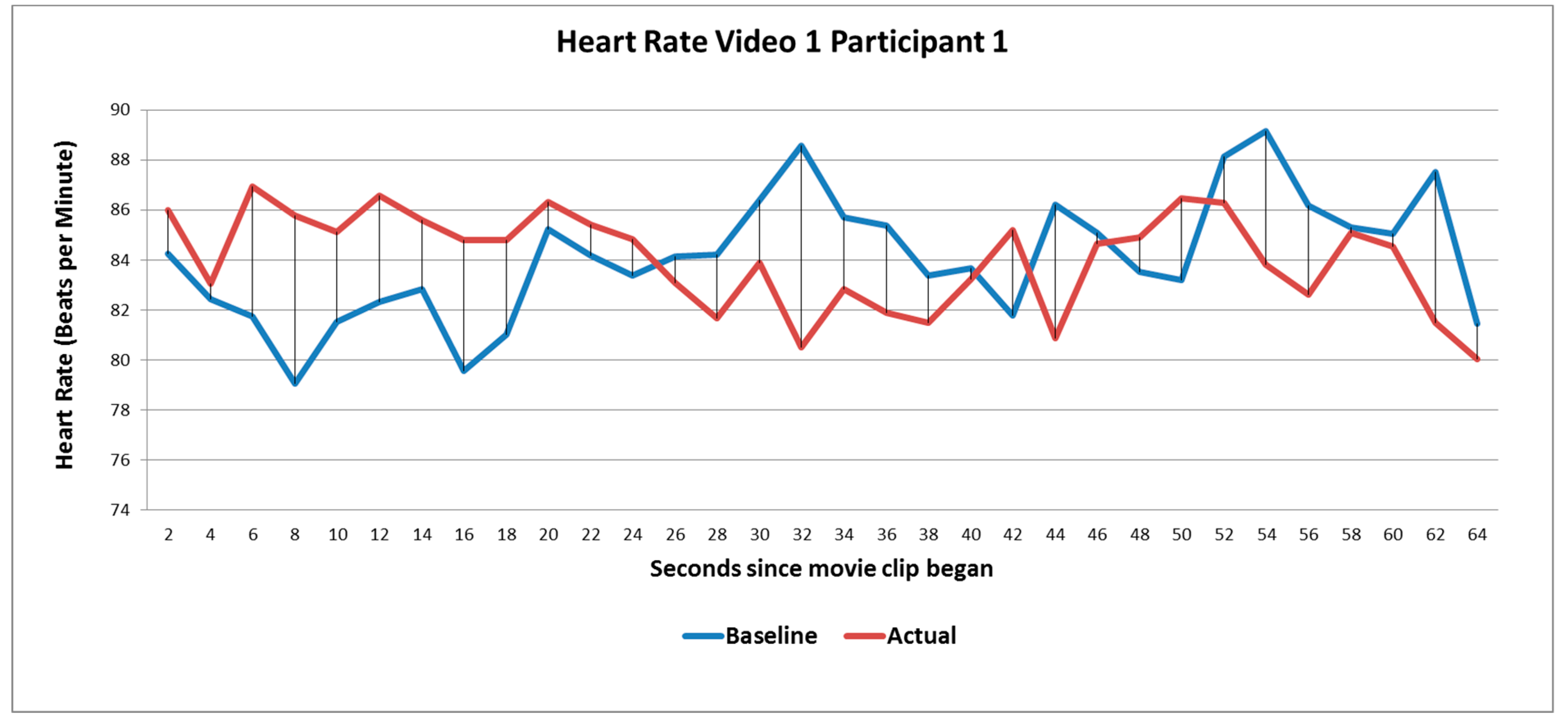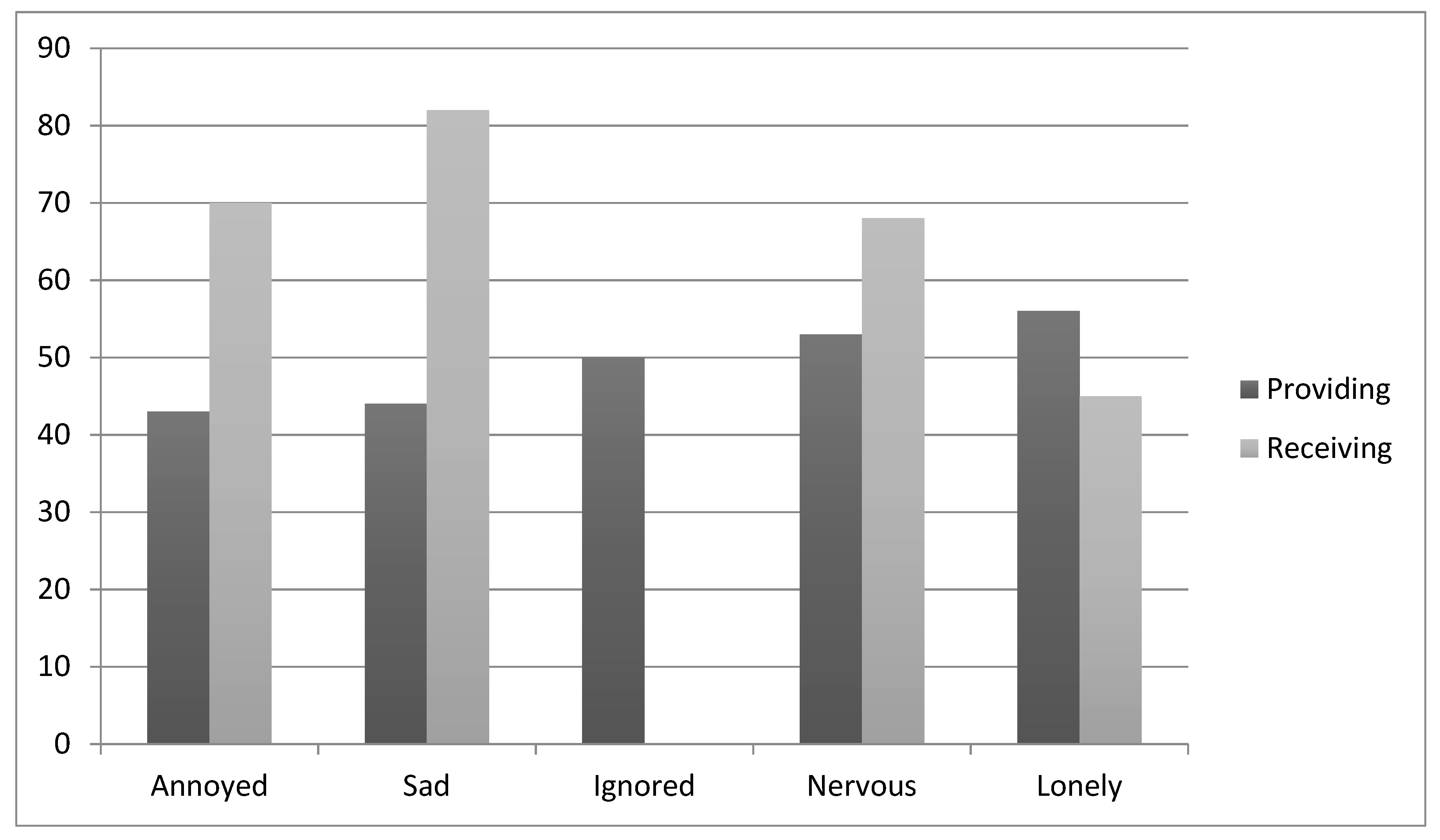Providing Excellent Customer Service Is Therapeutic: Insights from an Implicit Association Neuromarketing Study
Abstract
:1. Introduction
2. Background
3. Methods
3.1. Study 1: Laboratory Based Study
3.1.1. Participants
3.1.2. Materials
3.1.3. Protocol
3.1.4. Analysis
Physiological Responses
Impulse Test
3.1.5. Results
Physiological Measures
Impulse Test
3.1.6. Discussion and Conclusion
3.2. Study 2: Online Study
3.2.1. Participants
3.2.2. Materials
3.2.3. Protocol
3.2.4. Analysis
3.2.5. Results
Providing Excellent Customer Service
Receiving Excellent Customer Service
Providing Poor Customer Service
Receiving Poor Customer Service
Gender Differences
Age Differences
Cross-Cultural Differences
United Kingdom (least Impacted by Customer Service- Expectations much Lower)
Canada (Focused on “Providing”)
Australia (Receiving is More Emotionally Important than Giving)
3.2.6. Conclusions
4. General Discussion
4.1. Theoretical and Methodological Contributions
4.2. Implications for Managers and Organizations
Author Contributions
Funding
Conflicts of Interest
References
- Hochschild, A.R. The Managed Heart: Commercialization of Human Feeling; University of California Press: Oakland, CA, USA, 2003. [Google Scholar]
- Rafaeli, A.; Sutton, R.I. Busy stores and demanding customers: How do they affect the display of positive emotion? Acad. Manag. J. 1990, 33, 623–637. [Google Scholar] [CrossRef]
- Tsai, W.-C. Determinants and consequences of employee displayed positive emotions. J. Manag. 2001, 27, 497–512. [Google Scholar] [CrossRef]
- Bono, J.E.; Vey, M.A. Toward understanding emotional management at work: A quantitative review of emotional labor research. In Emotions in Organizational Behavior; Psychology Press: Abingdon, UK, 2005; pp. 224–244. [Google Scholar]
- Henderson, A. Emotional labor and nursing: An under-appreciated aspect of caring work. Nurs. Inq. 2001, 8, 130–138. [Google Scholar] [CrossRef] [PubMed]
- Goodwin, C.; Smith, K.L. Courtesy and friendliness: Conflicting goals for the service providers. J. Serv. Mark. 1990, 4, 5–20. [Google Scholar] [CrossRef]
- Grandey, A.A.; Fisk, G.M.; Mattila, A.S.; Jansen, K.J.; Sideman, L.A. Is “service with a smile” enough? Authenticity of positive displays during service encounters. Organ. Behav. Hum. Decis. Process. 2005, 96, 38–55. [Google Scholar] [CrossRef]
- Hennig-Thurau, T.; Groth, M.; Paul, M.; Gremler, D.D. Are all smiles created equal? How emotional contagion and emotional labor affect service relationships. J. Mark. 2006, 70, 58–73. [Google Scholar] [CrossRef]
- Plassmann, H.; Ramsøy, T.Z.; Milosavljevic, M. Branding the brain: A critical review and outlook. J. Consum. Psychol. 2012, 22, 18–36. [Google Scholar] [CrossRef]
- Winkielman, P.; Berridge, K.C. Unconscious emotion. Curr. Dir. Psychol. Sci. 2004, 13, 120–123. [Google Scholar] [CrossRef]
- Jeon, H.; Choi, B. The relationship between employee satisfaction and customer satisfaction. J. Serv. Market. 2012, 26, 332–341. [Google Scholar] [CrossRef]
- Kahneman, D. Thinking, Fast and Slow; Macmillan: London, UK, 2011. [Google Scholar]
- Kenning, P.H.; Plassmann, H. How neuroscience can inform consumer research. IEEE Trans. Neural Syst. Rehabil. Eng. 2008, 16, 532–538. [Google Scholar] [CrossRef]
- Mlodinow, L. Subliminal: How Your Unconscious Mind Rules Your Behavior; Vintage: New York, NY, USA, 2013. [Google Scholar]
- Zablah, A.R.; Franke, G.R.; Brown, T.J.; Bartholomew, D.E. How and when does customer orientation influence frontline employee job outcomes? A meta-analytic evaluation. J. Mark. 2012, 76, 21–40. [Google Scholar] [CrossRef]
- Forgas, J.P.; Williams, K.D.; Von Hippel, W. Social Judgments: Implicit and Explicit Processes; Cambridge University Press: Cambridge, UK, 2003; Volume 5. [Google Scholar]
- Yi, Y.; Nataraajan, R.; Gong, T. Customer participation and citizenship behavioral influences on employee performance, satisfaction, commitment, and turnover intention. J. Bus. Res. 2011, 64, 87–95. [Google Scholar] [CrossRef]
- Hartline, M.D.; Ferrell, O.C. The management of customer-contact service employees: an empirical investigation. J. Market. 1996, 60, 52–70. [Google Scholar] [CrossRef]
- Cho, Y.-N.; Rutherford, B.N.; Friend, S.B.; Hamwi, G.A.; Park, J. The role of emotions on frontline employee turnover intentions. J. Market. Theory Pract. 2017, 25, 57–68. [Google Scholar] [CrossRef]
- Judge, T.A.; Woolf, E.F.; Hurst, C. Is emotional labor more difficult for some than for others? A multilevel, experience-sampling study. Pers. Psychol. 2009, 62, 57–88. [Google Scholar] [CrossRef]
- Wang, M.; Liu, S.; Liao, H.; Gong, Y.; Kammeyer-Mueller, J.; Shi, J. Can’t get it out of my mind: Employee rumination after customer mistreatment and negative mood in the next morning. J. Appl. Psychol. 2013, 98, 989. [Google Scholar] [CrossRef] [PubMed]
- Harris, L.C.; Reynolds, K.L. The consequences of dysfunctional customer behavior. J. Serv. Res. 2003, 6, 144–161. [Google Scholar] [CrossRef]
- Spencer, S.; Rupp, D.E. Angry, guilty, and conflicted: Injustice toward coworkers heightens emotional labor through cognitive and emotional mechanisms. J. Appl. Psychol. 2009, 94, 429. [Google Scholar] [CrossRef] [PubMed]
- Zimmermann, B.K.; Dormann, C.; Dollard, M.F. On the positive aspects of customers: Customer-initiated support and affective crossover in employee–customer dyads. J. Occup. Organ. Psychol. 2011, 84, 31–57. [Google Scholar] [CrossRef]
- Dormann, C.; Zapf, D. Customer-related social stressors and burnout. J. Occup. Health Psychol. 2004, 9, 61. [Google Scholar] [CrossRef]
- Lee, N.; Broderick, A.J.; Chamberlain, L. What is ‘neuromarketing’? A discussion and agenda for future research. Int. J. Psychophysiol. 2007, 63, 199–204. [Google Scholar] [CrossRef] [PubMed]
- Nobel, C. Neuromarketing: Tapping into the “Pleasure Center” of Consumers. Available online: https://www.forbes.com/sites/hbsworkingknowledge/2013/02/01/neuromarketing-tapping-into-the-pleasure-center-of-consumers/#2f1415302745 (accessed on 13 October 2019).
- Dimofte, C.V. Implicit measures of consumer cognition: A review. Psychol. Mark. 2010, 27, 921–937. [Google Scholar] [CrossRef]
- Gawronski, B.; Payne, B.K. Handbook of Implicit Social Cognition: Measurement, Theory, and Applications; Guilford Press: New York, NY, USA, 2011. [Google Scholar]
- Brunel, F.F.; Tietje, B.C.; Greenwald, A.G. Is the implicit association test a valid and valuable measure of implicit consumer social cognition? J. Consum. Psychol. 2004, 14, 385–404. [Google Scholar] [CrossRef]
- De Houwer, J.; Teige-Mocigemba, S.; Spruyt, A.; Moors, A. Implicit measures: A normative analysis and review. Psychol. Bull. 2009, 135, 347. [Google Scholar] [CrossRef] [PubMed]
- Steinman, R.B.; Karpinski, A. The breadth-based adjective rating Task (BART) in consumer behavior. Mark. Lett. 2009, 20, 327–335. [Google Scholar] [CrossRef]
- Steinman, R.B.; Karpinski, A. The Single Category Implicit Association Test (SC-IAT) as a measure of implicit consumer attitudes. Eur. J. Soc. Sci. 2008, 7, 32–42. [Google Scholar]
- Calvert, G.; Geraldine, T.; Pathak, A.; Eamon, P.F. IMPULSE moment-by-moment test: An implicit measure of affective responses to audiovisual televised or digital advertisements. J. Advert. 2019. submitted. [Google Scholar]
- Calvert, G.; Fulcher, E.; Fulcher, G.; Foster, P.; Rose, H. Using implicit methods to develop an objective measure of media brand engagement. Int. J. Mark. Res. 2014, 56, 15–32. [Google Scholar] [CrossRef]
- Fazio, R.H.; Olson, M.A. Implicit measures in social cognition research: Their meaning and use. Annu. Rev. Psychol. 2003, 54, 297–327. [Google Scholar] [CrossRef]
- Foote, S.L. Arousal. Encycl. Psychol. 2000, 1, 237–240. [Google Scholar]
- Noteboom, J.T.; Barnholt, K.R.; Enoka, R.M. Activation of the arousal response and impairment of performance increase with anxiety and stressor intensity. J. Appl. Physiol. 2001, 91, 2093–2101. [Google Scholar] [CrossRef] [PubMed]
- Maison, D.; Greenwald, A.G.; Bruin, R.H. Predictive validity of the Implicit Association Test in studies of brands, consumer attitudes, and behavior. J. Consum. Psychol. 2004, 4, 4–415. [Google Scholar] [CrossRef]
- Yoon, G.; Vargas, P. The Subtle Influence of Check and X Marks: How Symbolic Markings Influence Judgment. J. Consum. Psychol. 2018, 4, 682–688. [Google Scholar] [CrossRef]
- Jacoby, L.L.; Witherspoon, D. Remembering without awareness. Can. J. Psychol. 1982, 36, 300. [Google Scholar] [CrossRef]
- Marcel, A.J. Conscious and unconscious perception: Experiments on visual masking and word recognition. Cogn. Psychol. 1983, 15, 197–237. [Google Scholar] [CrossRef]
- Tulving, E. Relations among components and processes of memory. Behav. Brain Sci. 1984, 7, 257–268. [Google Scholar] [CrossRef]
- Freund, A.M.; Blanchard-Fields, F. Age-related differences in altruism across adulthood: Making personal financial gain versus contributing to the public good. Dev. Psychol. 2014, 50, 1125. [Google Scholar] [CrossRef]
- Deaux, K. From individual differences to social categories: Analysis of a decade’s research on gender. Am. Psychol. 1984, 39, 105. [Google Scholar] [CrossRef]
- Markus, H.R.; Kitayama, S. Culture and the self: Implications for cognition, emotion, and motivation. Psychol. Rev. 1991, 98, 224. [Google Scholar] [CrossRef]
- Iacobucci, D.; Ostrom, A. Gender differences in the impact of core and relational aspects of services on the evaluation of service encounters. J. Consum. Psychol. 1993, 2, 257–286. [Google Scholar] [CrossRef]



| Positive Valence Words | Negative Valence Words |
|---|---|
| Excited | Weepy |
| Over-joyed | Stressed |
| Delighted | Sad |
| Contented | Heartbroken |
| Pleased | Lonely |
| Ecstatic | Ignored |
| Peaceful | Fed up |
| Emotional Prime Words | ||||||
|---|---|---|---|---|---|---|
| Excited | Confident | Content | Appreciated | Regular | Okay | Sad |
| Ecstatic | Fortunate | Comforted | Peaceful | Satisfactory | Fine | Lonely |
| Over-joyed | Engaged | Pleased | Relief | Pleasant | Normal | Ignored |
| Exhilarated | Proud | Happy | Calm | Nice | Expected | Annoyed |
| Energised | Thrilled | Loved | Satisfied | Fair | Usual | Nervous |
| Providing Service Targets “Being” | Receiving Service Targets “Feeling” | ||
|---|---|---|---|
| Positive | Negative | Positive | Negative |
| Helpful | Impolite | Relieved | Neglected |
| Friendly | Difficult | Special | Insecure |
| Sensitive | Confusing | Understood | Misconstrued |
| Excellent | Lazy | Encouraged | Ignored |
| Understanding | Thoughtless | Unique | Angry |
| Supportive | Rude | Respected | Insulted |
| Considerate | Cold | Wowed | Underwhelmed |
| Meaningful | Useless | Protected | Frustrated |
© 2019 by the authors. Licensee MDPI, Basel, Switzerland. This article is an open access article distributed under the terms and conditions of the Creative Commons Attribution (CC BY) license (http://creativecommons.org/licenses/by/4.0/).
Share and Cite
Calvert, G.A.; Pathak, A.; Ching, L.E.A.; Trufil, G.; Fulcher, E.P. Providing Excellent Customer Service Is Therapeutic: Insights from an Implicit Association Neuromarketing Study. Behav. Sci. 2019, 9, 109. https://doi.org/10.3390/bs9100109
Calvert GA, Pathak A, Ching LEA, Trufil G, Fulcher EP. Providing Excellent Customer Service Is Therapeutic: Insights from an Implicit Association Neuromarketing Study. Behavioral Sciences. 2019; 9(10):109. https://doi.org/10.3390/bs9100109
Chicago/Turabian StyleCalvert, Gemma Anne, Abhishek Pathak, Lim Elison Ai Ching, Geraldine Trufil, and Eamon Philip Fulcher. 2019. "Providing Excellent Customer Service Is Therapeutic: Insights from an Implicit Association Neuromarketing Study" Behavioral Sciences 9, no. 10: 109. https://doi.org/10.3390/bs9100109
APA StyleCalvert, G. A., Pathak, A., Ching, L. E. A., Trufil, G., & Fulcher, E. P. (2019). Providing Excellent Customer Service Is Therapeutic: Insights from an Implicit Association Neuromarketing Study. Behavioral Sciences, 9(10), 109. https://doi.org/10.3390/bs9100109





